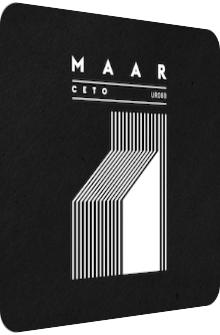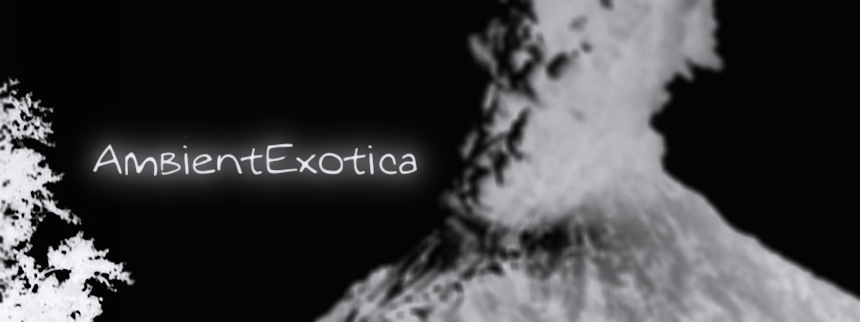
Maar
Ceto
2014
The term maar is a trusted part of every geologist’s basic vocabulary, describing a crater filled by a lake that was formed by a volcanic explosion. Very occasionally, this term can be used in conversations that do not fall into this category, as, for example, in this review. Enter the Chicagoan duo Joseph Clayton Mills and Michael Vallera aka Maar whose full-length debut Ceto is released in September 2014 on the Mexico City-based label Umor Rex Records in an edition of 80 hand-numbered pro-dubbed chrome tapes. Harboring seven glitchy Drone tracks which are available to stream and purchase at Bandcamp, Maar unite the supra-polished surfaces of their stealthy rhythm sections with similarly inorganic pulse rivers complete with appended coruscating sparks and mould them into a fitting caldera where machine-like drone descendants boost the feeling of being entrapped in an arcane antrum. Ceto is definitely no Hauntology work, let alone a Dark Ambient album, although its stark murkiness is a ubiquitous force, only elbowed away by glaring tone bursts ablaze with chromaticity. Here comes the good part though: Ceto is cleverly arranged, Mills and Vallera balance out the conflictive clashs more often than not, leading to bustling Ambient pieces filled with toxic excitement and asphyxiating air. The uneasiness is part of the plan, wholly embraced, infinitely nurtured… and suddenly revealing its viscid core of silk.
 Rectilineal but showcasing plasticity via 3D: Daniel Castrejón's artwork.
Rectilineal but showcasing plasticity via 3D: Daniel Castrejón's artwork.
A lilac cesspool of heterodyned – or was that heterodox? – frequencies, slowly unveiling before the eyes of the listening subject, replacing the mellifluous undercurrent of the first few seconds with an increasing immediacy as presented by the tachycardia turmoil frequency-wise: welcome to Dye, the mucous cotyledon that serves as the base for the endemics that reign within Ceto. Mills and Vallera sternly veneer the sylvan dreaminess in this polyhedric cannelure of over eight minutes in favor of a saltatory compunction-inducing amalgamation of screeching electric guitars, rusty blisters, sweeping scintillae and other artificial artifacts. However, Ambient isn’t dead, and as Dye progresses the threshold beneath the five-minute mark, saccharified legato cataracts float through. They are not necessarily ethereal, however, their granuloma does not exclusively genuflect before the power of Glitch either, for it rather showcases moments of soothingness as well. Especially the final minute sports a flat aureole of propitiation. The title track Ceto follows afterwards, an unkempt ca(u)ldron whose seething back is filled with a curiously streamlined pattern of high voltage vesicles, cascades of electric current and wondrously deep gongs of the Detroit kind. Despite the ubiquitous buzzes, the atmosphere is only mildly tense. The humming and whirring, though upfront, is translucent enough to peek behind this electric fence, allowing the listening subject to spot synth-oid protrusions in syringa.
The ten minute gigantomachy Low Surface Brightness is next, a nebulous superfluid filled with viscoelastic fog flutters, shuffling flickers and diaphanous fibers. On high volume levels, Maar’s entity reveals a clever serration of sound, sustain and silence, a process that is iterated throughout the tape, but specifically cajoling here due to the eminent equanimity. Instead of a belligerent decortication, the focus on the textural interplay and an omnipresent nothingness results in a parallax peritoneum that spawns an unexpected amount of organic traits such as various driblets and Angkor Wat-like gamelan chimes. A soft amount of echoes amplifies the plasticity further, but without blurring the clarity of the permutation. The adjacent At/Equal then turns out to be a curious critter. Its title may evoke Maar’s ongoing attempts at equalizing the antagonistic forces so that the gustatory aura is not overly mephitic; the attached soundscape, however, differs strikingly in that its physiognomy is more akin to an austere metronome. Everything is precise and in order. The ophidian snare in tandem with the grim bassline becomes a Tartarean force. The sustain of a classic piano fades into the cracks, many of its chords emanating a chlorotic uneasiness… and amid all these tone sequences remain the treeless buzzes and internecine beat blebs. This is Maar’s darkest hour for sure.
Having passed the ominous shapeshifter At/Equal, Joseph Clayton Mills and Michael Vallera concentrate yet again on an almost beatless but blotchy circumambience with their last three tracks. The cheekily titled Untitled is another murky affair alright, supercharged with circular saw scratches, scraggy plasticizers, morse scythes and claustrophobic synth curtains whose actual source may well be a heavily processed guitar. While the majority of Maar’s material at least hints at a nucleus of beauty that is, if not tangible, then at least detectable amid the caproic interstices, here on Untitled the hexanoic acid prevents such teary-eyed notions of languor. The jagged jitters and heatings system recirculation successfully camouflage even a glint of hope, making this track more of a hopeless dungeon than a hazardous illuminant. The same can be said about S and its retrojected mid–90’s nihilism. Drums that are both hollow and aqueous, a gigantic thunderstorm of flashing laser pulses, asbestus capsules, caustic solutions and a mockingly mild-mannered pulsating endpoint continue to alter the photometry, agglutinating it with a darkness galore. Luckily, the actual finale Tres does not succumb to Lovecraftian dimensions any further, but rather ventures into a grayish abyss that is quite mellow in its own right, believe you me. Cauterized clicks, fizzling ventilation pipes, ligneous adjuvants, in short: a bokeh of droning machines is presented in this last installment. Everything remains peaceful and almost placid. It is as if only the antecedent raw corrosive powers, subversive threats and disintegrating obstacles made this somnolent epiphany possible.
Maar’s Ceto fits perfectly into the overall scheme of Umor Rex and its back catalog, and my usual pairing of Drone/Glitch is also perfectly suitable a description here, even though this dualism may only technically cover the tape’s genre aspects. The duo’s aesthetic decisions are of equal importance though. The carefully created – and curated – array of machine drones, glittering gongs, reverberated clicks and masked guitar protuberances is always warm, but not necessarily warmhearted. The levels of energy, the sheer amount of heat and humid corners make Ceto a vibrantly calorific tape that runs on all cylinders, even in those instances where silence threatens to take over. The synth-like globs that are hidden in most of the tracks are gorgeously resplendent counterpoints to the glitchier side. Once Joseph Clayton Mills and Michael Vallera rev up the beats and rhythm sections, Ceto turns into a flashback, a retrogressive allure whose bedazzling percussion is mercilessly accompanied by the oomph of those beats. Stainless steel and industrialism work well together after all. It is, I believe, no coincidence that Ceto’s front artwork features a cautiously grainy black backdrop – in lieu of a monochromatic blackness – and adamantly rectilineal 3D patterns hued in a semi-argentine contrast. It is the silvery aura, the alloy of orderly metallics and the contrapuntal whirling vortex of frequencies that is key to the innermost elemental occurrences of Maar’s full-length debut. A volcanic tape.
Further listening:
- Ceto is available at Bandcamp and the distributors Morr Music and Thrill Jockey.
- One half of Maar tweets, and Umor Rex is always present as well: @Michael_Vallera & @UmorRex.
Ambient Review 378: Maar – Ceto (2014). Originally published on Sep. 24, 2014 at AmbientExotica.com.
